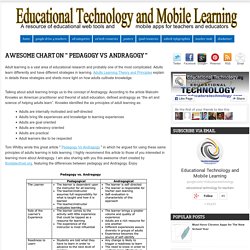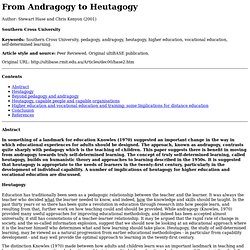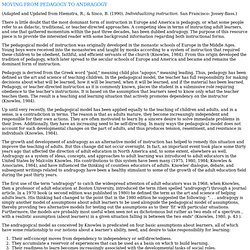

Awesome Chart on " Pedagogy Vs Andragogy " Adult learning is a vast area of educational research and probably one of the most complicated.

Adults learn differently and have different strategies in learning. Adults Learning Theory and Principles explain in details these strategies and sheds more light on how adults cultivate knowledge. Talking about adult learning brings us to the concept of Andragogy. According to the article Malcolm Knowles an American practitioner and theorist of adult education, defined andragogy as “the art and science of helping adults learn”. Knowles identified the six principles of adult learning as: Adults are internally motivated and self-directedAdults bring life experiences and knowledge to learning experiencesAdults are goal orientedAdults are relevancy orientedAdults are practicalAdult learners like to be respected. Adult Learning Theory and Principles.
Become familiar with Adult Learning Theory and the six principles of adult learning Adult Learning Theory Part of being an effective educator involves understanding how adults learn best (Lieb,1991).

Andragogy (adult learning) is a theory that holds a set of assumptions about how adults learn. Andragogy emphasises the value of the process of learning. It uses approaches to learning that are problem-based and collaborative rather than didactic, and also emphasises more equality between the teacher and learner. Andragogy as a study of adult learning originated in Europe in 1950's and was then pioneered as a theory and model of adult learning from the 1970's by Malcolm Knowles an American practitioner and theorist of adult education, who defined andragogy as "the art and science of helping adults learn" (Zmeyov 1998; Fidishun 2000). What do you mean by 'adult learning principles'? From Andragogy to Heutagogy.
Author: Stewart Hase and Chris Kenyon (2001) Southern Cross University Keywords: Southern Cross University, pedagogy, andragogy, heutagogy, higher education, vocational education, self-determined learning.

Article style and source: Peer Reviewed. Original ultiBASE publication. Original URL: Contents Abstract In something of a landmark for education Knowles (1970) suggested an important change in the way in which educational experiences for adults should be designed. Heutagogy Education has traditionally been seen as a pedagogic relationship between the teacher and the learner. The distinction Knowles (1970) made between how adults and children learn was an important landmark in teaching and learning practices in vocational education and training, and in higher education. This revolution recognises the changed world in which we live.
The thrust that underscores these approaches is a desire to go beyond the simple acquisition of skills and knowledge as a learning experience. Conclusion References. MOVING FROM PEDAGOGY TO ANDRAGOGY. (Adapted and Updated from Hiemstra, R., & Sisco, B. (1990).

Individualizing instruction. San Francisco: Jossey-Bass.) There is little doubt that the most dominant form of instruction in Europe and America is pedagogy, or what some people refer to as didactic, traditional, or teacher-directed approaches. A competing idea in terms of instructing adult learners, and one that gathered momentum within the past three decades, has been dubbed andragogy. The purpose of this resource piece is to provide the interested reader with some background information regarding both instructional forms. The pedagogical model of instruction was originally developed in the monastic schools of Europe in the Middle Ages. Pedagogy is derived from the Greek word "paid," meaning child plus "agogos," meaning leading. Up until very recently, the pedagogical model has been applied equally to the teaching of children and adults, and in a sense, is a contradiction in terms. Www.engineersmedia.com.au/journals/aaee/pdf/AJEE_15_1_McAuliffe F2.pdf. What is Heutagogy?
Heutagogy101-ChrisKenyon. Advancing the Theory and Practice of Self-Determined Learning. Education 3.0 and the Pedagogy (Andragogy, Heutagogy) of Mobile Learning. The evolution of the web from Web 1.0 to Web 2.0 and now to Web 3.0 can be used a metaphor of how education should also be evolving, as a movement based on the evolution from Education 1.0 to Education 3.0.

I discussed this in Schools are doing Education 1.0; talking about doing Education 2.0; when they should be planning and implementing Education 3.0. Many educators are doing Education 1.0; talking about doing Education 2.0; when they should be planning and implementing Education 3.0. This post compares the developments of the Internet-Web to those of education. The Internet has become an integral thread of the tapestries of most societies throughout the globe. The web influences people’s way of thinking, doing and being; and people influence the development and content of the web. Source: This translates into moving from an education approach driven by essentialism or instructivism to one that is based on constructivism and connectivism.
Essentialism is defined as: Like this: From Andragogy to Heutagogy. Education 3.0 and the Pedagogy (Andragogy, Heutagogy) of Mobile Learning. Www.engineersmedia.com.au/journals/aaee/pdf/AJEE_15_1_McAuliffe F2.pdf. Www.engineersmedia.com.au/journals/aaee/pdf/AJEE_15_1_McAuliffe F2.pdf.